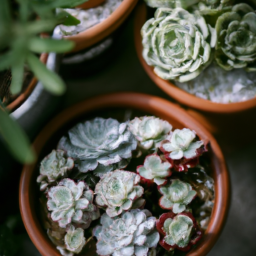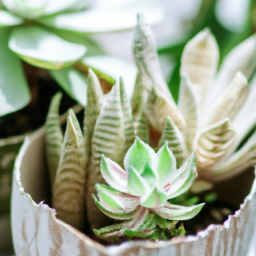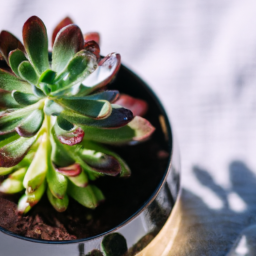
Are you looking to bring some greenery into your home but don’t have a green thumb? Succulents for indoors may be the perfect solution for you! These low-maintenance plants are not only beautiful to look at, but they also thrive in indoor environments with minimal care. Whether you’re a seasoned plant parent or a beginner looking to add some green to your space, succulents are a great choice. In this blog post, we’ll explore the world of succulents for indoors and provide tips on how to care for these unique plants in your home. So grab a cup of tea and let’s dive into the wonderful world of indoor succulents!
Benefits of Growing Succulents Indoors
Introduction
As an expert in succulents, I can attest to the numerous benefits of growing these unique plants indoors. Succulents are not only aesthetically pleasing but also have practical advantages that make them a great choice for indoor gardening. In this guide, I will delve into the various benefits of growing succulents indoors and provide you with tips on how to care for them effectively.
1. Air Purification
One of the key benefits of growing succulents indoors is their ability to purify the air. Succulents have the unique ability to absorb carbon dioxide during the day and release oxygen at night, making them ideal plants for improving indoor air quality. This can help reduce the levels of toxins in your home and create a healthier living environment for you and your family.
In addition to releasing oxygen, succulents also absorb harmful volatile organic compounds (VOCs) commonly found in indoor spaces. These compounds are emitted from household items such as paints, cleaning products, and furniture, and can have negative effects on our health. By having succulents indoors, you can effectively filter out these toxins and breathe cleaner air.
Some of the best succulents for air purification include aloe vera, snake plant, and spider plant. These plants are known for their ability to remove toxins from the air and are easy to care for, making them perfect choices for indoor spaces.
2. Stress Reduction
Another benefit of growing succulents indoors is their ability to reduce stress and improve overall well-being. Studies have shown that being around plants, such as succulents, can have a calming effect on our minds and bodies. The presence of greenery in indoor spaces has been linked to lower stress levels, increased focus, and improved mood.
Succulents, with their unique shapes and colors, can help create a sense of tranquility and relaxation in your home. Taking care of these plants can also be a therapeutic activity, allowing you to unwind and de-stress after a long day. Whether you place them on your desk, windowsill, or coffee table, succulents can bring a touch of nature into your indoor environment and promote a sense of well-being.
To maximize the stress-reducing benefits of succulents, consider creating a dedicated green space in your home where you can display a variety of plants. Surround yourself with succulents of different shapes and sizes to create a calming oasis that you can retreat to whenever you need a break from the hustle and bustle of daily life.
3. Low Maintenance
One of the main reasons why succulents are popular indoor plants is their low maintenance requirements. Succulents are well-adapted to survive in arid conditions and do not require frequent watering, making them ideal for busy individuals or those with a black thumb. These plants store water in their leaves, stems, or roots, allowing them to thrive in dry indoor environments with minimal care.
When growing succulents indoors, it is important to provide them with well-draining soil, adequate sunlight, and occasional watering. Overwatering is one of the most common mistakes people make when caring for succulents, as it can lead to root rot and other issues. By following simple care instructions and paying attention to the specific needs of each succulent variety, you can enjoy beautiful and healthy plants with minimal effort.
Some easy-to-care-for succulents that are perfect for indoor environments include echeveria, haworthia, and sedum. These plants come in a variety of shapes and colors, making them versatile choices for adding visual interest to your home. With their low maintenance requirements and unique aesthetic appeal, succulents are the perfect choice for anyone looking to bring a touch of nature into their indoor space.

Best Types of Succulents for Indoor Environments
Choosing the Right Succulents
When it comes to choosing the best types of succulents for indoor environments, there are several factors to consider. First and foremost, you’ll want to think about the amount of light your space receives. Some succulents thrive in bright, direct sunlight, while others prefer indirect light or even low light conditions.
Another important factor to consider is the size of the succulent. Some varieties, such as Echeveria and Aloe, can grow quite large and may not be suitable for small indoor spaces. On the other hand, smaller succulents like Haworthia and Sedum are perfect for windowsills or shelves.
Lastly, consider the care requirements of the succulent. Some varieties are more forgiving of neglect, while others require regular watering and specific soil conditions. It’s important to choose succulents that fit your lifestyle and level of gardening experience.
In general, some of the best types of succulents for indoor environments include:
– Aloe Vera: Known for its soothing gel, Aloe Vera is a popular choice for indoor gardens. This succulent thrives in bright, indirect light and requires minimal watering.
– Echeveria: With their rosette-shaped leaves and vibrant colors, Echeveria are a stunning addition to any indoor space. These succulents prefer bright, direct sunlight and well-draining soil.
– Haworthia: Haworthia are small, low-growing succulents that are perfect for windowsills or terrariums. They prefer indirect light and only need to be watered sparingly.
Caring for Indoor Succulents
Once you’ve chosen the right succulents for your indoor space, it’s important to provide them with the proper care to ensure they thrive. Here are some tips for caring for indoor succulents:
– Light: Most succulents require at least six hours of bright, indirect sunlight per day. Place your succulents near a south or west-facing window for the best results.
– Watering: Succulents are drought-tolerant plants, so it’s important not to overwater them. Allow the soil to dry out completely between waterings, and be sure to use a well-draining potting mix.
– Temperature: Succulents prefer warm temperatures during the day and cooler temperatures at night. Keep your indoor succulents away from drafts or extreme temperature fluctuations.
– Soil: Use a cactus or succulent potting mix that provides good drainage. Avoid using regular potting soil, as it can hold too much moisture and lead to root rot.
– Fertilizing: During the growing season, you can fertilize your indoor succulents with a diluted, balanced fertilizer. Be sure to follow the instructions on the fertilizer package carefully.
Troubleshooting Common Issues
Even with the best care, indoor succulents can sometimes run into problems. Here are some common issues you may encounter and how to address them:
– Overwatering: If your succulent’s leaves are turning yellow or mushy, it’s likely being overwatered. Allow the soil to dry out completely before watering again, and adjust your watering schedule as needed.
– Sunburn: Sunburn is a common issue for succulents that are exposed to too much direct sunlight. Move your succulent to a shadier location and gradually acclimate it to brighter light.
– Pests: Indoor succulents can attract pests like mealybugs and spider mites. To combat pests, you can use insecticidal soap or neem oil, or simply wipe the leaves with a damp cloth.
By choosing the right succulents, providing them with the proper care, and addressing any issues that arise, you can enjoy a thriving indoor succulent garden that adds beauty and greenery to your space.

Tips for Caring for Succulents Indoors
Choosing the Right Succulents
When it comes to caring for succulents indoors, the first step is choosing the right plants for your space. There are many different types of succulents to choose from, each with its own unique care requirements. Some popular indoor succulents include Aloe Vera, Echeveria, and Jade Plant. Before purchasing any succulents, make sure to research their specific care needs to ensure they will thrive in your home.
Once you have selected the perfect succulents for your indoor space, it is important to consider the lighting conditions in your home. Succulents thrive in bright, indirect light, so be sure to place them near a window where they will receive plenty of sunlight throughout the day. If you do not have access to natural light, you can also use grow lights to provide your succulents with the light they need to thrive.
In addition to lighting, it is important to consider the temperature and humidity levels in your home when caring for succulents indoors. Succulents prefer warm, dry environments, so be sure to keep them away from drafty windows or doors. You can also increase the humidity levels around your succulents by placing a tray of water near them or using a humidifier in the room.
Watering and Feeding Your Succulents
One of the most important aspects of caring for succulents indoors is watering them properly. Succulents are drought-tolerant plants, so it is important not to overwater them. A good rule of thumb is to water your succulents when the top inch of soil is dry to the touch. Be sure to water your succulents thoroughly, allowing the excess water to drain out of the bottom of the pot to prevent root rot.
In addition to watering, it is important to feed your succulents regularly to ensure they receive the nutrients they need to thrive. You can use a balanced liquid fertilizer diluted to half strength and feed your succulents once a month during the growing season. Be sure to follow the instructions on the fertilizer package to avoid overfeeding your plants.
When it comes to repotting your succulents, it is best to do so in the spring when they are actively growing. Choose a pot that is slightly larger than the current one and fill it with well-draining soil to prevent waterlogged roots. Gently remove the succulent from its current pot, loosen the roots, and place it in the new pot, adding soil around the roots to secure it in place.
Preventing and Treating Common Succulent Problems
While succulents are relatively easy to care for, they are still susceptible to a few common problems that can affect their health. One of the most common issues with indoor succulents is overwatering, which can lead to root rot and other diseases. To prevent overwatering, be sure to allow the soil to dry out between waterings and use a well-draining soil mix.
Another common problem with succulents is pests, such as mealybugs and spider mites, which can infest your plants and cause damage. To prevent pests, be sure to inspect your succulents regularly for any signs of infestation, such as sticky residue or webbing. If you do notice pests on your plants, you can use a natural insecticidal soap to treat them and prevent further damage.
In addition to overwatering and pests, succulents can also be affected by diseases such as fungal infections and rot. To prevent these issues, be sure to provide your succulents with plenty of air circulation and avoid overcrowding them in their pots. If you do notice any signs of disease, such as discolored or mushy leaves, be sure to remove the affected parts of the plant and treat it with a fungicide to prevent further spread.
By following these tips for caring for succulents indoors, you can ensure that your plants thrive and bring a touch of nature into your home. With the right care and attention, your succulents will reward you with their unique beauty and resilience for years to come.
Recap of this article
Succulents are a popular choice for indoor plants due to their low maintenance and unique appearance. These plants are known for their ability to store water in their leaves, making them perfect for those who may forget to water their plants regularly. With a wide variety of shapes, sizes, and colors to choose from, succulents can add a touch of greenery to any indoor space.
When choosing succulents for indoors, it’s important to consider factors such as lighting and watering needs. Most succulents prefer bright, indirect sunlight, so be sure to place them near a window or in a well-lit area. Additionally, succulents should be watered sparingly, allowing the soil to dry out completely between waterings to prevent root rot. With a little bit of care and attention, succulents can thrive indoors and bring a touch of nature into your home.
Top FAQs:
Q1. Can succulents thrive indoors?
A1. Yes, many succulents can thrive indoors as long as they receive adequate sunlight, proper watering, and well-draining soil.
Q2. What are some popular indoor succulent varieties?
A2. Some popular indoor succulent varieties include Echeveria, Haworthia, Aloe Vera, and Jade Plant. These varieties are known for their ability to adapt to indoor environments.
Q3. How often should I water indoor succulents?
A3. It is important to let the soil dry out completely between waterings to prevent root rot. Depending on the succulent variety and the environment, you may need to water your indoor succulents every 1-2 weeks.
Q4. What kind of sunlight do indoor succulents need?
A4. Indoor succulents thrive in bright, indirect sunlight. Place them near a south or west-facing window where they can receive at least 6 hours of sunlight per day.
Q5. How can I prevent my indoor succulents from becoming leggy?
A5. To prevent indoor succulents from becoming leggy, rotate them regularly to ensure even sunlight exposure on all sides. Additionally, consider pruning them back to encourage new growth and maintain a compact shape.
Dr. Olivia Green is a botanist with over two decades of experience in indoor plant cultivation. She holds a Ph.D. in Plant Biology and has dedicated her career to researching plant behavior in controlled environments. Dr. Green is passionate about helping plant enthusiasts master the art of indoor gardening through her extensive knowledge and practical insights.


